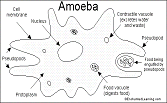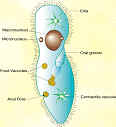Biologue: Ameba and Paramecium Under the Microscope
|
|
|
Ameba and Paramecium, two unicellular organisms, have just been sucked into a pipette by Professor Bungle. Following is a conversation overheard between them.
Ameba: (Waving his pseudopods) Wow!!! Do you know what happened? It felt like we were just swept into a tunnel.
Paramecium: Rubbing his cilia. This is definitely not cool - look around and you will see that we are totally surrounded! Where are our friends, phytoplankton and zooplankton?
Ameba and Paramecium are now being squeezed out of the pipette by Professor Bungle and land in the center of a slide.
Ameba: Boy am I glad to be out of that "thing." Where are we now?
Paramecium: Moving his cilia to move around. Looks like we are in a depression in the middle of a glass slide.
Ameba: Does that mean we will get depressed? Why would Professor Bungle want us there anyway?
Paramecium: Rapidly beating his cilia as he moves around to survey the scene. According to Webster's dictionary, depression can also mean an area that is sunk below its surroundings …. but I am worried that we will also get the other kind of depressed if we stay here too long! Look - there is a long tube coming down on top of us!
Ameba: waving his pseudopods frantically. I sure hope it doesn't come crashing down on top of us!
Paramecium: Boy that was close! If it moved another centimeter, it would have crashed right into us!
Now Professor Bungle is rotating another tube.
Ameba: Peeking out from under the tube. Aaah…I think I know where we are. We are on a stage!!!
Paramecium: Wow! I have never been on a stage before - who's in the audience?
Ameba: It's not that kind of a stage! It's the stage on an instrument called a microscope.
Paramecium: Microscope??? What's that?
Ameba: Stretching his pseudopods out. It's just what its roots mean - micro means small and scope means that it is an optical instrument.
Paramecium: Does that mean that it magnifies things? Makes them bigger? If so, we're in big trouble! Before now no one knew we existed.
Ameba: You're right! In fact, now they call us microorganisms. Can you figure out where that word comes from?
Paramecium: I guess if micro is small and organism is a living thing, it must mean the study of living things that are too small to see without that thing you call a microscope.
Ameba: Clapping his pseudopods together. Precisely!
Paramecium: How does this thing work? I am beginning to get a little hot and it looks awfully bright down here!
Ameba: You're right! It's called a compound light microscope because, in order for the specimen to be seen, light must pass through the stage that we are on now.
Paramecium: Who's going to see us?
Ameba: Professor Bungle is going to look at us, but he can also project us on a video screen so many students can observe us at once.
Paramecium: Waving his cilia in excitement. Boy - We will be famous and then all our fellow microorganisms will be asking for our autograph. You know it's real hard trying to hold a pen with your oral groove! I certainly wouldn't use my anal pore! How does this microscope "thing" work anyway?
Ameba: Handing Paramecium a diagram of the microscope. Take a look at this picture - it will be easier to understand. The position and shape of the lenses are what allows it to magnify.
Paramecium: Isn't that what Professor Bungle has in his eyeglasses?
Ameba: Precisely! It actually has two lenses; one in the eyepiece (aka ocular) and the other is called the objective lens. In fact, many microscopes have several objectives and that is why we can be seen under different magnifications.
Paramecium: Is that what those numbers mean on that tube that is right over us?
Ameba: Looking out from the slide to read the number. Yes. Right now it looks like the number is 10X on this objective that the good Professor is using. That means we are probably seen 100X bigger than we really are!
Paramecium: Looking surprised. What a minute, Ameba. You have an extra zero on the magnification. Why would it be marked 10X and not 100X if we are 100X bigger than life!
Ameba: Good point. That is why it is called a compound microscope. It uses two lenses for magnification and the total magnification is the product of each lens' magnification.
Paramecium: Slow down! If my nucleus is as good as I think it is, that means that the other lens in this microscope must be 10X too.
Ameba: Your nucleus is working well … at least for now. If you remember, the other lens is in the eyepiece or ocular which is what Professor Bungle looks at when he uses this microscope.
The nosepiece is rotated.
Paramecium: Look up Ameba - the tube on top of us is rotating! A new tube is coming and it looks like this one might really hit us!
Ameba: Don't worry. Luckily for us, Professor Bungle, despite his name, knows how to use this microscope. He knows not to touch that knob (course adjustment knob) under high power. If you watch him, he will just be using that smaller knob called the fine adjustment knob to get us into exact focus.
Paramecium: Looking at a monitor where the image is projected. Wow!!! I am looking even bigger. What happened?
Ameba: I think we are under what they call high power. When Professor Bungle rotated the nosepiece, he put a longer objective lens on us - Peering out of the side of the slide to read. Yes … I was right, as usual. It says 40X and the other one said 10X.
Paramecium: That means that we are now 400X bigger than life! We are even 4X bigger than we were under the low power objective. This is making me feel really important!
Ameba: If you look carefully at the screen, you will notice that we don't seem to have as much space around us.
Paramecium: You're right, again, Ameba. As the magnification increases, the area in view will decrease. It's like the zoom lens on a camera. If you make everything small, you can see more of the background and the subject of the picture. If you increase the magnification, less can be seen.
Ameba: Wouldn't it be a pity if Professor Bungle couldn't see all of me!
Paramecium: Sometimes the Professor wants to study only a specific structure - say like your nucleus, and he wants that to be as magnified as possible.
Ameba: Oh, I see. Is there any limit as to how much larger my image can get?
Paramecium: Sure. It depends on the quality and type of microscope. If you magnify something and it can't be seen clearly (that's known as resolution), it's not worth looking at it. That's why some microscope are more expensive than others - it's all in the quality of the lenses.
Ameba: I heard that there are some microscopes that we don't want to be near because we can't be seen alive. Is that true?
Paramecium: You heard right! Those are the electron microscopes that use electrons instead of light and are operated in a vacuum (you know---no air). Let's hope that Professor Bungle doesn't get any ideas about that!
Professor Bungle takes the slide off the stage and pours the culture back into the water.
Ameba: Boy … that was fun the way we went down that slide. It's sure good to be back home.
Paramecium: Looking at the diagram of the microscope. Before you divide, let's see if you know all the parts of the microscope.
Vocabulary
Resolution Microorganism magnification zooplankton anal pore phytoplankton optical pseudopod nucleus cilia oral groove
written by Joyce Kent 9/02

